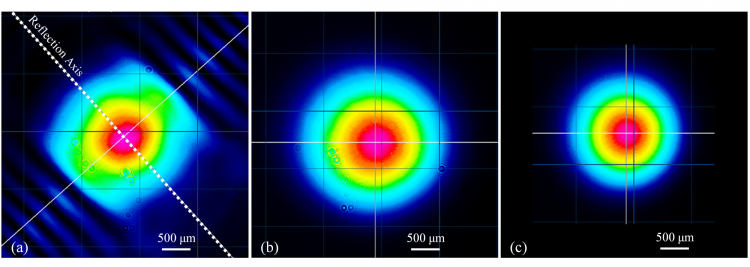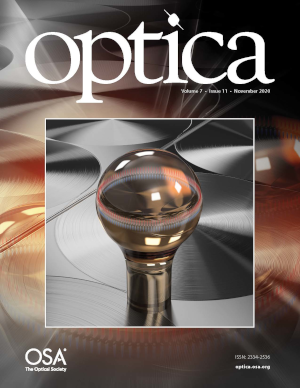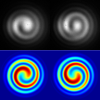Interests
Quantum technology
We are very interested in practical quantum technology, in both fibers and integrated photonics. This enables both practical applications, scalability and remote sensing. Recent work has included a theoretical analysis of a fiber-based interferometer, using two-mode squeezed vacuum and new cascaded architecture. We are also actively exploring a variety of integrated photonic platforms for quantum light sources, classical technology to enable implementation of quantum experiments, and processing using passive integrated photonic circuits.
- G. Krueper, C. Yu, S. B. Libby, R. Mellors, L. Cohen, and J. T. Gopinath, “Realistic Model of Entanglement-Enhanced Sensing in Optical Fiber,” Optics Express 30, 8652-8666 (2022).
- G. Krueper, L. Cohen and J. T. Gopinath, “New Cascaded Architecture for Classical and Quantum Multiparameter Sensing”, arXiv:2304.08545 [quant-ph], https://doi.org/10.48550/arXiv.2304.08545, Physical Review A 111, 012618 (2024).
Optofluidics
Optofluidics, the combination of microfluidics, nanotechnology and photonics, offers some distinct advantages over current photonics technology: tunability, high index contrast, and dynamic system reconfiguration. Recent developments include switches, microscopes, reconfigurable lenses, and liquid core waveguides. Specifically, the group is interested in developing microfluidic devices for adaptive optics applications. The group is also interested in nonlinearities of nanoparticles in solution and lasers compatible with microfluidic devices. These sources can be integrated with existing microfluidic technology, allowing the development of 'lab-on-chip' systems for biological applications. We have spent the past few years studying electrowetting lenses, in collaboration with Professor Victor Bright. We recently demonstrated individually addresssable electrowetting lenses and have been evaluating their capability to correct wavefront distortion. We have also demonstrated record low power electrowetting lenses and recently, a monolithic prism for beam steering.
- M. Zohrabi, W. Y. Lim, R. H. Cormack, O. D. Supekar, V. M. Bright, and J. T. Gopinath, "Lidar system with nonmechanical electrowetting-based wide-angle beam steering," Optics Express, vol. 27, p. 4404-4415(2019).
- B. N. Ozbay, G. L. Futia, M. Ma, V. M. Bright, J. T. Gopinath, E. G. Hughes, D. Restrepo, and E. A. Gibson "Three dimensional two-photon imaging of neural activity in freely moving mice using a miniature fiber coupled microscope with dynamic focusing," Scientific Reports, vol. 8, p. 108 (2020).
- S. D. Gilinsky, D. N. Jung, G. L. Futia, M. Zohrabi, T. A. Welton, O. D. Supekar, E. A. Gibson, D. Restrepo, V. M. Bright, and J. T. Gopinath, “Tunable liquid lens for three-photon excitation microscopy” Biomedical Optics Express 15, 3285-3300 (2024).
Integrated photonics for the mid-infrared: chalcogenide integrated optics
The infrared region, from 3-20 microns, contains many vibrational resonances of molecules. The infrared is often called the 'chemical fingerprint' region with many applications in sensing. Quantum-cascade laser technology is the basis for many sources in the region, but the lasers are limited in spectral range, bandwidth, and power. Other options for sources are being investigated, ranging from direct generation with solid-state or fiber lasers, to nonlinear conversion of near-infrared sources. The goal is the development of compact, efficient, broad-bandwidth, high-power infrared sources with potential extensions to the THz regime. We are also studying chalcogenide materials for nonlinear mid-infrared devices, that can be operated with just a few milliwatts of continuous wave light. We currently are characterizing potential materials in the near-infrared for nonlinearity and absorption. We are collaborating with with Professor Won Park on the project. Research opportunities on this project range from materials characterization to laser development and sensor engineering.
- M. R. Krogstad, S. Ahn, W. Park, and J. T. Gopinath, "Nonlinear characterization of Ge28Sb12Se60 bulk and waveguide devices," , Optics Express, vol. 23, p. 7871 (2015).
- J. Zhu, T. M. Horning, M. Zohrabi, W. Park and J. T. Gopinath, “Photo-induced writing and erasing of gratings in As2S3 chalcogenide microresonators,” Optica 7, 1645-1648 (2020).
Semiconductor lasers

Semiconductor lasers, with their potential for efficient and compact operation are the ideal source for many applications including sensors, optical clocks, pump sources, data storage, and lidar. High efficiency operation and large wavelength tuning ranges are achievable, but the application space is constrained by power and pulse energy and pulse width limits. Techniques to improve the performance of semiconductor lasers such as beam combining and beam quality improvement schemes are being investigated. The goal is the development of high power, single mode, pulsed, highly efficient lasers for applications that currently require solid-state and fiber lasers.
- R. D. Niederriter, B. N. Ozbay, G. L. Futia, Emily A. Gibson, and J. T. Gopinath, "Compact diode laser source for multiphoton biological imaging ," Biomedical Optics Express, vol. 8, p. 315 (2016).
- Y. L. Simmons, K. J. Underwood, O. D. Supekar, B. M. Heffernan, T. A. Welton, E. A. Gibson, and J. T. Gopinath, "Femtosecond diode-based time lens laser for multiphoton microscopy," Biomed. Opt. Express 12, 6269-6276 (2021)
Ultrafast spectroscopy
Spectroscopy, both in the time and frequency domain, can be used as a tool for both device design / characterization and for fundamental scientific investigations. Bulk materials, nanoparticles, novel materials and broadband devices can all be investigated with spectroscopy. Characterization of scattering times and nonlinearities is critical for the design of integrated photonic devices such as lasers and switches. Opportunities include modeling and simulation, fabrication, and experimental design and testing.
- K. J. Underwood, A. F. Briggs, S. D. Sifferman, V. B. Verma, N. Sirica, R. P. Prasankumar, S. -W. Nam, K. L. Silverman, S. R. Bank and J. T. Gopinath, "Strain dependence of Auger recombination in 3 mm GaInAsSb/GaSb type-I active regions," Applied Physics Letters vol. 116, p.262103 (2020).
- K. N. Dickson, Y. Lange Simmons, A. F. Ricks, A. M. Skipper, A. F. Briggs, A. J. Muhowski, S. R. Bank, and J. T. Gopinath, “Impact of Mechanically Applied Strain on Auger Recombination in InGaAs Multiple Quantum Wells,” Applied Physics Letters 126, 032105 (2025).
Orbital angular momentum of light
The recent discovery of "twisted light" is very exciting because of the potential applications ranging from high-resolution biological imaging to increased bandwidth for communications. Additionally, twisted light carries orbital angular momentum, which can be used to spin micromachines or can interact with rotating objects. The group is interested in studying new ways to generate and detector orbital angular momentum, as well as apply it to fields including imaging, sensing, and rotation from the macroscale to the nanoscale.
- R. D. Niederriter, M. E. Siemens, and J. T. Gopinath "Continuously tunable orbital angular momentum generation using polarization maintaining fiber,"Optics Letters, vol. 41, p. 5019 (2016).
- B. M. Hefferman, S. A. Meyer, D. Restrepo, M. E. Siemens, E. A. Gibson and J. T. Gopinath , "A fiber-coupled stimulated emission depletion microscope for bend-insensitive through-fiber imaging,", Scientific Reports, vol. 9, p. 11137 (2019).
- B. Heffernan, P. Riley, O. Supekar, S. Meyer, D. Restrepo, M. Siemens, E. A. Gibson, and J. T. Gopinath, “Two-photon fiber-coupled super-resolution microscope for biological imaging,” APL Photonics 7, 036102 (2022), DOI: 10.1063/5.0075012.



